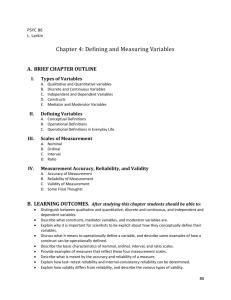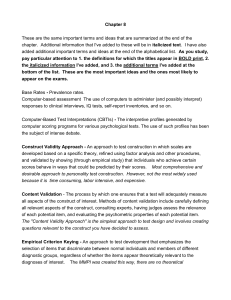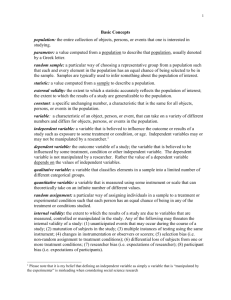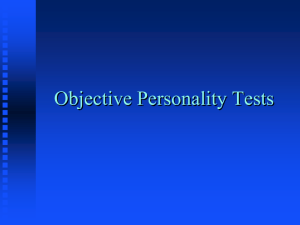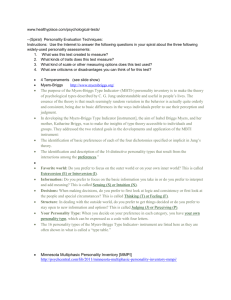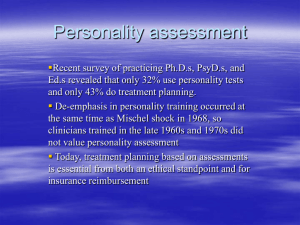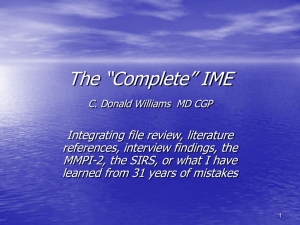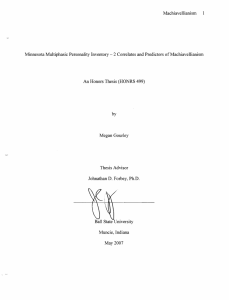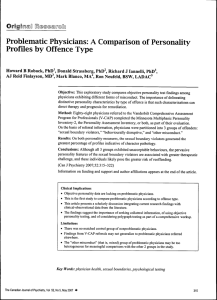Personality Inventory
advertisement
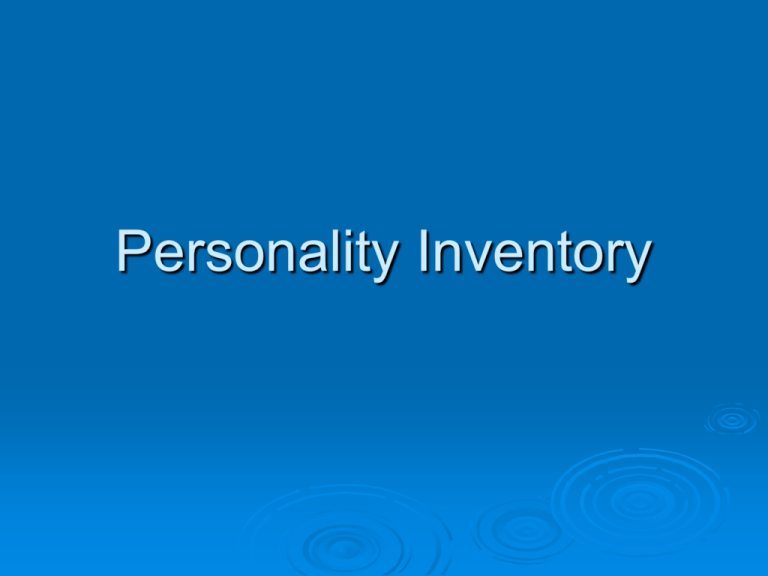
Personality Inventory Reliability and Validity reliability: does it yield consistent result? validity: does it measure what it is supposed to measure? • Construct validity: the extent to which an instrument measures some hypothetical construct such as intelligence, extraversion, etc. Convergent validity Divergent validity Discriminant validity • Predictive validity: the extent that a test predicts future. Self-Report Inventories Sixteen Personality Factors Questionnaire multiple-choice test developed by Cattell and his colleagues in the 1940's factor analysis (based on the correlation coefficient) in a quest to try to discover all the fundamental dimensions of human personality http://en.wikipedia.org/wiki/16_Personality_Fa ctors Self-Report Inventories Revised NEO Personality Inventory (NEO PI-R) measure of the Five Factor Model: OCEAN • Openness Fantasy Aesthetics Feelings Actions Ideas Values • Conscientiousness Competence Order Dutifulness Achievement Striving Self-Discipline Deliberation • Extraversion 1. Warmth 2. Gregariousness 3. Assertiveness 4. Activity 5. Excitement Seeking 6. Positive Emotion • Agreeableness Trust Straightforwardness Altruism Compliance Modesty Tendermindedness • Neuroticism Anxiety Hostility Depression Self-Consciousness Impulsiveness Vulnerability to Stress Self-report Inventories California Psychological Inventory created in a similar manner to the MMPI not concerned with maladjustment or clinical diagnosis, but concerned itself with more "normal" aspects of personality Millon Clinical Multiaxial Inventory-3 intended to provide information on psychopathology, modeled on four scales • • • • 14 Personality Disorder Scales 10 Clinical Syndrome Scales Correction Scales (which help detect inaccurate responding) 42 Grossman Personality Facet Scales Original MMPI (1930s) Hathaway and McKinley empirical keying approach the clinical scales were derived by selecting items that were endorsed by patients known to have been diagnosed with certain pathologies. not based on any particular theory, and thus the initial test was not aligned with the prevailing psychodynamic theories of that time. capture aspects of human psychopathology that were recognizable and meaningful despite changes in clinical theories. Minnesota “normals” (n= 724) versus appropriate criterion groups. Started with 1000 items and ended with 504. Problems of MMPI-1 Did not discriminate the clinical groups intended. High correlation among scales. MMPI-2 Aims of MMPI-2 Revise and modernize by deleting objectionable, nonworking, and obsolete items. Expand the item pool to include additional items addressing contemporary clinical problems and applications (e.g. homosexual, introversion ) Maintain the basic clinical scales. New representative, nationally based sample. Collect extensive data for validation. MMPI-2 567 items, all true-or-false format, and usually takes between 1 and 2 hours to complete. an infrequently used abbreviated form of the test that consists of the MMPI-2's first 370 items. The shorter version has been mainly used in circumstances that have not allowed the full version to be completed (e.g., illness or time pressure MMPI-2 Clinical Scales MMPI-2 Clinical Scales MMPI-2 Validity Scales L scale: Lie, Client "faking good” F Scale: Infrequency, Client "faking bad" • less than 10% of normals answered the items in the way. K Scale: Defensiveness, Denial/Evasiveness Scoring and Interpretation Like many standardized tests, scores on the various scales of the MMPI-2 is not representative of how "well" or "poorly" someone has done on the test. Rather, analysis looks at relative elevation of factors compared to the various norm groups studied. Raw scores on the scales are transformed into a standardized T-scores (Mean or Average equals 50, Standard Deviation equals 10) making interpretation easier for clinicians. Projective Tests Draw-a-person Developed originally by Florence Goodenough in 1926 inferring children's cognitive developmental levels with little or no influence of other factors e.g. language barriers, special needs. Rorschach first created in 1921,came in to widespread use after 1960 5 black cards and 5 color cards Subject shown card and asked what it looks like Interpretation involves 3 sets of variables • Location – where on the blot subjects saw what they saw • Content – what subjects report seeing, and • Determinants – what made subjects report what they say. form, shading, and color. The first of the ten cards in the Rorschach inkblot test. It has been reported that popular responses include bat, badge and coat of arms.

